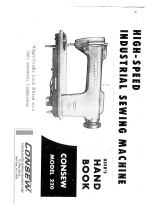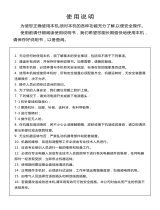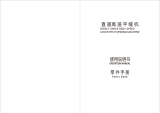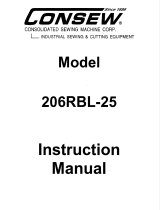Page is loading ...

INDUSTRIAL SEWING MACHINE INSTRUCTION MANUAL
5600SW

CONTENTS
1. Brief introduction 1
2. Main specifications 1
3. Machine installation and operation preparation 1
1. Machine installation 1-3
2. Operation preparation and notice before running 3-4
4. Machine operation 5-6
1. Coordination among needle, thread and materials 5
2. Install the needle 5
3. Winding the bobbin thread 5-6
5. Machine adjustment 6-9
1. Adjust the needle thread tension and bobbin thread tension 6-7
2. Adjust the pressure of presser foot 7
3. Adjust the safety clutch device 7-9
10-13
14-17
18-19
20-23
24-25
26-27
28-29
30-31
1. 5400TW machine casting components
2. 5600SW machine casting components
3. Upper shaft and presser foot components
4. Needle bar and lower feed components
5. Lower shaft thread looping components
6. Stitch length adjustment components
7. Knee lifter and winding components
8. Lubrication components
9. Accessories 32-33
Operation instruction
Parts manual

Operation instructions

1
2
5400TW machine adopts straight double needle and two
vertical auto-lubricating hooks for thread looping,
sliding lever for thread take up to form two lines of
lockstitch seam. The upper and lower shafts are
supported by needle bearing and driven by
toothed belt, plunger oil pump lubrication system,
compound feed mechanism of feed dog, walking
foot and needle, so even if for long stitch length or
sewing long materials, it can deal with them freely. .
5600SW sewing machine adopts single
straight needle and vertical auto-lubricating hook for
thread looping, it has all of the advantages of
5400TW. .
Both of the models are widely used in the factories
of suitcase, tent, cushion, leather goods, apparel,
mat, etc. .
5600SW
Medium and heavy weight materials
1200s.p.m
9mm
36mm
8mm by hand
More than 16mm by pedal
Large vertical auto-lubricating hook
DP 17 Nm125 180
6.4mm (standard)
Auto-lubricating
A
B
Special needle gauge available (mm):3.2,4,4.8,8,
9.5,12.7,16,19,25.4.
Applications
Max. Sewing speed
Max. Stitch length
Needle bar stroke
Presser foot lift height
Hook
Needle
Needle gauge
Lubrication
Model
1. Machine installation
1.1 Location of the machine
The machine must be located on the rigid and flat
floor for ensuring its smooth operation and reducing
its vibration. Meanwhile, a rubber mat should be
inserted between the machine stand and the floor for
further reducing the running noise. .
1.2 Install the oil pan (Fig. 1)
Put the oil pan into the table cutout and place the
four cushions on the four corners of the cutout,
finally fix the cushion and oil pan on the table by
nail. .
1.3 Install the machine head (Fig. 2)
Make the hinge A of machine head engaged with
hinge socket B on the table, then turn the machine
head till it is seated on the frame of table cutout,
please keep the turning freely. .

3
5
4
C
B
A
A
B
C
E
D
A
1.4 Install the presser foot lifting controller (Fig. 3)
First connect the chain B with presser foot lift lever
C by hooks A, then install the pedal assembly D on
the rung of the stand, move the controller E leftward
or rightward to make the chain in one line, fix it
with bolt and nut, finally connect the hook with the
controller E.
(An automatic presser foot lifter is also available,
please refer to parts manual Part 7. "Knee lifter and
winding components")
.
.
1.5 Install the thread stand (Fig. 4)
The thread stand should be located on the right
backside of the table. Threading should be smooth
when sewing. When the machine head is turned
backward, it should not be touched with the thread
stand, then tighten the nut A. .
1.6 Install the motor (Fig. 5)
Move the motor C leftward or rightward to make the
hand wheel belt groove A and motor pulley belt
groove B run in line. .

6
20 ~30
A
B
C
D
E
F
G
10~12mm
3
7
8
B
A
1.7 Connecting the clutch lever to the pedal (Fig. 6)
A. The optimum tilt angle of pedal against floor is
approx. 20 30 . .
B. Adjust the clutch of motor so that the clutch lever
C and draw bar B run in line. .
C. The machine hand wheel should rotate
counter-clockwise for normal sewing when view
from opposite side of balance wheel. The motor
should rotate in the same direction. The rotation can
be reversed by reversing the plug of motor (turn
over 180 ) .
D. Adjust the tension of V-belt F by moving the
motor up and down. The proper tension of V-belt is
a slack of 10 12mm when the belt is depressed at
the belt span by finger. .
2. Operation preparation and notice before running
2.1 Clearing the machine
Before the head is packed, all of the parts of the
machine are coated with anti-rust grease, meanwhile
the grease can harden and the dust can cover the
machine, surface during long time storage and
shipment, so, the dust and grease must be cleared by
clean cloth with gasoline. .
2.2 Examination
Although every machine is conformed by strict
inspection and test before delivery, the parts of the
machine may be loose and deformed after long
distance transportation with jolt. A thorough
examination must be performed. Turn the balance
wheel slightly by hand to check if there is running
obstruction, parts collision, uneven resistance and
abnormal noise. If any of these exist, adjustment
must be made accordingly before running. .
2.3 Notice before running
A. Oiling (Fig. 7)
Oil amount should be filled according to the marks
in the oil pan, Mark A refers to the highest of oil
amount; Mark B refers to the lowest, be careful that
the oil amount should not be lower than Mark B,
otherwise the machine parts can not be fed with oil
and cause overheat and collision. .
Please be sure to use machine oil 18# or HJ-7.

9
10
4
11
A
B. When the machine starts for initial time or reuse
after a long time, the proper oil amount should be filled
in the sections of machine shown by arrows in Fig. 8,9.
When it is in operation, please observe the oil sparking
in oil screen to check the oil condition. .
C. When a new machine starts running, for extending its
lift, please run at a medium and low speed (1000s.p.m)
for about a month and then raise the speed gradually. .
D. Please turn off the power when it is not in use or the
operator leaves away from it.
.
E. Replace the oil every month, when replacing, fully
drain off the old oil in the oil pan and add the new one.
F. For 5400TW, the needle gauge options are: 6.4,
3.2,4,4.8,8,9.5,12.7,16,19,24.5mm. To get it, the needle
plate, inner and outer presser foot, needle holder, feed
dog, left and right sliding plate, thread guide should be
changed, the standard needle gauge is 6.4mm, for the
other needle gauge, the relevant parts can be ordered
from the factory. .
1. Coordination among needle, thread and materials
Please use needle DP 17 or 135 17, Nm125 180, the
coarseness of needle should be in accordance with the
nature of materials. If stitching on heavy weight
materials with a slim needle, the needle will be broken
easily. Needle skipping or thread breakage will also
occur. On the contrary, stitch on tightly materials with a
very coarse needle, the materials will be destroyed
because of over-big needle hole, so the needle and
thread should be properly selected. .
2. Install the needle (Fig. 11)
Turn the hand wheel to lift the needle bar to its highest
position, loosen the needle set screw A, fully insert the
needle shank up to the bottom of needle holder, keep the
long grooves of the two needles opposite with each
other, then tighten the set screw as shown in Fig.(a), For
single needle, keep the long groove of needle facing the
left of the operator as shown in Fig.(b).
Note: Fig.(c) insufficient insertion or Fig. (D) wrong
direction of needle groove is incorrect.
.
.
Oil screen
Single
needle
Clearance
Long groove leftward

13
14
A
B
A
B
A
B
A
12
5
C
B
A
E
D
F
3. Winding the bobbin thread
3.1 The method of winding
Insert the bobbin B into winder shaft, threading the
thread A to upper and lower holes of pin E, then to
thread tension disc F, draw the thread tip and wind
thread several circles around bobbin B, put the
winding lever D into bobbin B, then it can automatic
winding when sewing. (If only winding, not sewing,
please lift the presser foot.)
Please don't overfill the bobbin thread, otherwise the
thread will loosen down from the bobbin. The
optimum capacity of bobbin thread is fill about 80%
of bobbin outside diameter, and this can be adjusted
by screw D. After finish, thread can be cut by thread
cutter shown in Fig. 12. Wind the thread A several
circles around cutter C, draw the thread and the
thread is cut.
.
.
3.2 Threading (Fig. 13)
A. Every thread should be drawn through thread hole
A, when using light and smooth thread (polyester or
long silk thread), it should be drawn through thread
hole B.
B. Keep the thread take-up lever at its highest
position, threading the needle thread in the following
numerical order.
.
.
3.3 Stitch length (Fig.14)
The stitch length can be regulated by stitch length
dial A. Turn it counter-clockwise to expand its
length and clockwise to shorten its length. The
numbers on dial show the sizes of the stitch length in
mm.
For reverse feed, press down feed lever B to perform
reverse sewing. Release the lever, the feed lever can
reset automatic and the forward sewing is resumed.
.
.
Thread
Detailed picture

6
17
15
C
B
A
16
3.4 Placing bobbin (Fig. 15)
Note: when bobbin is placed into the bobbin case, the
thread should be wound properly in the correct direction
shown in the figure. .
3.5 Drawing thread from the bobbin (Fig. 16)
A. Draw the thread end to bobbin slot shown in the
figure, and pull it out down through the inner bobbin
stop piece.
B. Hold the thread end with left hand, turn the hand
wheel slowly and get the bobbin thread, then draw them
a little apart from the presser foot.
.
.
1. Adjust the needle thread tension and bobbin
thread tension
All forms of stitches are shown in Fig. 20
The normal stitch of sewing machine is shown in Fig.
17A. If stitch is abnormal, the puckering and thread
breakage will occur, the needle thread tension and
bobbin thread tension should be adjusted so that the
normal stitch can be obtained. .
Normal stitch seam
Needle thread too loose or bobbin thread too tight
Needle thread too tight or bobbin thread too loose
Inner stop piece
Thread
Thread
Thread
Hook
Hook
Sliding plate
Sliding plate

7
18
21
19
20
A. If the stitch seam shows as Fig. 17B, indicates
that the needle thread tension is too tight or the
bobbin thread tension is too loose. Please turn the
thread tension nut counter-clockwise to release the
needle thread pressure; or turn the bobbin lace
adjusting screw with a screwdriver to increase the
bobbin thread tension.( See Fig. 18,19)
B. If the needle thread tension is too loose or the
bobbin thread tension is too tight shown as Fig. 17C.
Please turn the thread tension nut clockwise to
increase the needle thread pressure; or turn the
bobbin lace adjusting screw with a screwdriver to
decrease the bobbin thread tension. (See Fig. 18,19)
For special sewing with special thread, the tension
needed can be obtained by adjusting the power and
stroke of the thread take-up spring.
.
.
.
The pressure of presser foot should be adjusted
according to the thickness of the sewing materials. If
stitch on heavy weight materials, the pressure should
be increased by turning the pressure adjusting screw
on the back of machine head clockwise, on the
contrary, turn it counter-clockwise. .
2. Adjust the pressure of presser foot (Fig.20)
The function of safety clutch device is to prevent the
hook and toothed belt from being damaged when the
needle thread is drawn into the hook for abnormal
load during the operation. .
3. Adjust the safety clutch device
3.1 The function of safety clutch device (Fig.21)
A. When the safety clutch is functioning, the toothed
belt will remove the load and the hook shaft will stop
rotating, only the upper shaft still rotates, and the
machine stops work.
B. Clean off the needle thread which is draw into the
hook.
C. Turn the toothed belt shaft by hand to check if the
hook shaft can turn smoothly, then reset the safety
clutch device.
.
.
.
Adjusting screw
Loosen
Tighten
Nut
Increase
Decrease
Increase
Decrease
Pressure adjusting
screw
Safety clutch device
Toothed-belt pulley
Shaft
Stopper

8
24
22
23
3.2 How to reset the safety clutch device (Fig.22)
A. While press down the button on the bed surface with
left hand, turn the hand wheel slowly with right hand in
the direction shown in Fig. 22 (clockwise).
B. When the stopper brakes the hand wheel, more
strength is needed to turn the balance wheel to reset the
safety clutch device.
C. Release the button.
D. So the resetting is OK and put the bobbin into hook.
(See Fig.15)
.
.
.
.
3.3 How to adjust the strength on the safety clutch
device (Fig.23)
A. When the white mark of the eccentric pin aims at the
centre of the lower shaft, indicates that the strength on
the safety clutch is the minimum. When the white mark
points outward, the strength is properly increased.
B. For adjusting the strength of it, move the belt and
loosen the set screw of eccentric pin, and turn the
eccentric pin.
C. After adjustment, please tighten the set screw.
.
.
.
3.4 Adjust the upper feed mechanism (Fig.23)
If the upper and lower feed are not in timing during
sewing, the long hole of the horizontal feed crank(right)
should be adjusted to get the length of upper feed.
Adjusting as follows:
A. Loosen the special stud.
B. Move the stud upward to decrease the amount of
upper feed.
C. Move the stud downward to increase the amount of
upper feed. Theoretically, when it is on the reference
line of the horizontal feed crank, the upper feed amount
equals to the lower feed amount.
D. After adjustment, tighten the special stud.
.
.
.
.
.
.
Handwheel
Button
White mark
Eccentric pin
Belt
Tighten
Loosen
Lower shaft
Set screw
Link
Horizontal shaft crank (right)
Reference line
Special stud
Upper layer feed decreaseUpper layer feed decreaseUpper layer feed decrease
Upper layer feed increaseUpper layer feed increaseUpper layer feed increase

9
25
26
Oil amount
adjusting screw
Oil amount
adjusting screw
Oil amount
adjusting screw
3.5 Adjust the vertical stroke of presser foot (Fig. 25)
When stitch on the very elastic materials or the
thickness of sewing materials changes, the
adjustment should be done in the following order: .
.
.
.
A. Loosen the special stud.
B. When the central line distance between the special
stud and the presser foot lifting rear crank becomes
shorter, the vertical stroke of presser foot will
become longer, on the contrary, the distance becomes
longer, the stroke will become shorter.
C. After adjustment, tighten the special stud. The
common vertical stroke of presser foot can be
adjusted within the range of 2 6mm.
3.6 Adjust the hook oil amount (Fig. 26)
It adopts plunger full auto-lubricating system, even
at a very low speed, it still can supply and suck oil
very well. Generally, only the hook oil amount can
be adjusted, the others cannot be adjusted. The hook
oil amount can be controlled by the oil amount
adjusting screw. First loosen the nut of adjusting
screw, turn the screw clockwise to increase the oil
amount, on the contrary, decrease the oil amount.
After adjustment, tighten the nut. .
Increase Increase Increase
Decrease
Increase Increase Increase
DecreaseDecreaseDecrease
Special stud
Crank link
Crank

Parts manual

1
2
3
4
5
6
7
8
9
10
11
68
12
13
14
15
16
17
18
19
20
21
22
23
24
25
26
27
28
29
30
31
32
33
34
35
36
37
38
39
40
41
42
43
44
45
46
47
48
49
50
51
52
53
54
55
56
57
58
59
60
61
62
63
64
65
66
67
14
45
12
13
1.
5400TW ma
chine casting components
10

1
2
3
4
5
6
7
8
9
10
11
12
13
14
15
16
17
18
19
20
21
22
23
24
25
26
27
28
29
30
31
32
33
34
35
36
37
38
39
40
41
42
43
1
1
2
1
3
1
1
4
1
2
1
15
15
2
1
1
1
1
1
1
1
1
1
1
1
1
1
2
1
2
1
1
1
1
1
1
1
1
1
1
1
1
1
Machine bed
Machine arm
Pin
Screw
Screw
Model label
Brand label
Rivet
Upper thread guide
Screw
Back cover
Screw
Washer
Cover
Front slide plate
Screw
Thread take-up lever cover
Back front cover
Screw
Spring
Thread retainer
Lower thread finger
Screw
Screw
Screw
Screw
Middle thread finger
Rubber plug
8.5
Face plaft
Screw
Upper thread finger
Guide set plate
Oil stopper set plate
Oil stopper
Needle plate
Pin shaft
Thread releasing lever
Right sliding plate
Left sliding plate
Rubber plug 14.5
Rubber plug 12.7
Back fitting cover
Rubber plug 12.7
43WF1-001
43WF1-002
43WF1-003B
43WF1-004B
1WF1-015
1WF1-016
1WF1-017
1WF1-011
22T1-007
1WF1-032
1WF1-038
1WF1-039
1WF1-019
1WF1-030
1WF1-027
1WF1-028
1WF1-003
1WF1-004
1WF1-005
1WF1-034
1WF1-036
1WF1-007
1WF1-006
1WF1-018
1WF1-013
1WF1-009
1WF1-008
1WF1-012
1WF1-021
1WF1-020
1WF1-035
1WF1-037
1WF1-023
1WF1-033
1WF1-040
1WF1-029
1WF1-022
1WF1-031
1WF1-014
A6 30 GB117-86
M10 35 GB70-85
M10 35 GB5781-85
2.5 5 GB827-86
SM11/64" 40/8
SM11/64" 40/9
PE
SM11/64" 32/5.4
SM9/64" 40/6.5
SM11/64" 40
SM9/64" 40
SM3/16" 28
11
1.
5400TW machine casting components
No .
Part number
Name
Qt.
Remark

1
2
3
4
5
6
7
8
9
10
11
68
12
13
14
15
16
17
18
19
20
21
22
23
24
25
26
27
28
29
30
31
32
33
34
35
36
37
38
39
40
41
42
43
44
45
46
47
48
49
50
51
52
53
54
55
56
57
58
59
60
61
62
63
64
65
66
67
14
45
12
13
1.
5400TW mac
hine casting components
12

44
45
46
47
48
49
50
51
52
53
54
55
56
57
58
59
60
61
62
63
64
65
66
67
68
1
2
2
2
2
1
3
2
2
4
1
2
2
1
1
1
1
1
1
1
1
1
1
1
1
Thread tension fixing bracket assembly
Thread guide bracket
Thread guide plate
Spring
Thread guide b acket screw assembly
Thread releasing pin (short)
Thread tension nut
Thread tension spring
Thread releasing disc
Thread tension disc
Screw
Screw
Thread controlling disc assembly
Screw
Stop plate
Thread take-up spring
Thread take-up spring shaft
Screw
Thread releasing pin (long)
Thread tension retaining plate
Thread releasing spring
Spring retaining plate
Screw
Rubber plug
Thread guide pin
r
1WF1-010A
1WF1-010B
1WF1-010C
1WF1-010D
1WF1-010E
1WF1-010M
1WF1-010H
1WF1-010G
1WF1-010S
1WF1-010F
1WF1-010R
1WF1-010Q
1WF1-010J
1WF1-026
1WF1-025
1WF1-010K
1WF1-010I
1WF1-024
1WF1-010L
1WF1-010W
1WF1-010P
1WF1-043
22T2-004
43WF1-006
35WF1-006
SM9/64" 40/4.5
SM/64" 40/4.5
1.
5400TW machine casting components
13
No .
Part number
Name
Qt.
Remark

1
2
3
4
5
6
7
8
9
10
11
12
13
14
15
16
17
18
19
20
21
22
23
24
25
26
27
28
29
30
31
32
33
34
35
36
37
38
39
40
41
42
43
44
46
47
48
49
50
51
52
53
54
55
56
57
58
59
60
61
62
63
64
14
45
2.
5400SW ma
chine casting components
43
12
13
65
14

1
2
3
4
5
6
7
8
9
10
11
12
13
14
15
16
17
18
19
20
21
22
23
24
25
26
27
28
29
30
31
32
33
34
35
36
37
38
39
40
41
1
1
2
1
3
1
1
4
1
2
1
15
15
2
1
1
1
1
1
1
1
1
1
1
1
1
1
2
1
1
1
1
1
1
1
1
1
1
1
1
1
Machine bed
Machine arm
Pin
Screw
Screw
Model label
Brand label
Rivet
Upper thread guide
Screw
Back cover
Screw
Washer
Cover
Front slide plate
Screw
Thread take-up lever cover
Back front cover
Screw
Lower thread finger
Oil felt
Screw
Screw
Screw
middle thread finger
8.5
Face plate
Screw
Upper thread finger
Guide set plate
Oil stopper set plate
Oil stopper
Needle plate
Right sliding plate spring retainer
Thread releasing lever
Right sliding plate
Left sliding plate
14.5
12.7
Back fitting cover
Rubber plug 12.7
Rubber plug
Rubber plug
Rubber plug
44WF1-003
43WF1-002
44WF1-002
44WF1-005
1WF1-015
1WF1-016
1WF1-017
1WF1-011
22T1-007
1WF1-032
1WF1-038
1WF1-039
1WF1-019
1WF1-030
1WF1-005
9WF1-001
9WF1-002
1WF1-034
1WF1-036
1WF1-007
1WF1-006
1WF1-018
1WF1-013
1WF1-009
1WF1-008
1WF1-012
1WF1-021
1WF1-020
9WF1-004A
1WF1-043
1WF1-023
1WF1-033
1WF1-040
1WF1-029
1WF1-022
1WF1-031
1WF1-034
A6 30 GB117-86
M10 35 GB70-85
M10 35 GB5781-85
2.5 5 GB827-86
SM11/64" 40/8
SM11/64" 40/9
PE
SM11/64" 32/5.4
SM3/16" 28
15
No .
Part number
Name
Qt.
Remark
2.
5400S
W mac
hine casting components

1
2
3
4
5
6
7
8
9
10
11
12
13
14
15
16
17
18
19
20
21
22
23
24
25
26
27
28
29
30
31
32
33
34
35
36
37
38
39
40
41
42
43
44
46
47
48
49
50
51
52
53
54
55
56
57
58
59
60
61
62
63
64
14
45
43
12
13
65
16
2.
5400SW machine ca
sting components
/







